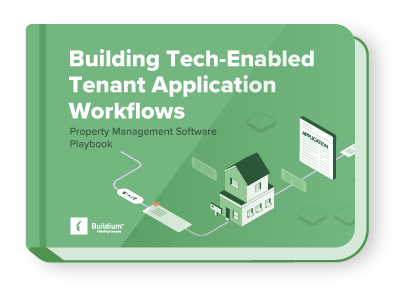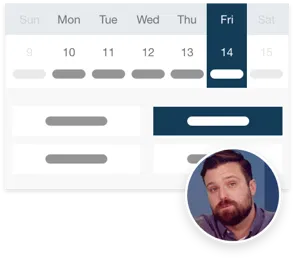North Carolina Rental Market Trends in 2025
In recent years, North Carolina has emerged as one of the most attractive states in the U.S. for residents and investors alike, with a booming population, diverse and resilient regional economies, and a favorable balance between affordability and demand. From the tech-fueled growth of Raleigh to the financial strength of Charlotte and the coastal charm of Wilmington, the Tar Heel State presents a wide range of opportunities for rental investors and property managers. But as we’ll discuss throughout this post, it’s important to keep in mind that North Carolina has also seen an influx of new construction that’s impacting occupancy and rent growth in the near term.
This post will reveal rental market statistics and insights for each of the 5 North Carolina rental markets we’ve chosen to highlight, including inventory growth, rent growth, vacancy rates, cap rates, and property price appreciation. We’ll also highlight economic and demographic trends in each market.
Top 5 Rental Markets in North Carolina for 2025
Without further ado, here are 5 North Carolina rental markets where our research indicates growth opportunities lie in 2025.

Market #1: Greensboro, NC
The Greensboro metro area’s 789,842 residents make it the third-most populous city in the state. It’s located within the Piedmont Triad, a region in central North Carolina that also includes High Point and Winston-Salem.
Greensboro’s economic roots trace back to the nineteenth century, when it became a hub for textile manufacturing and rail transport. The city also developed a strong presence in tobacco processing and furniture manufacturing, industries that defined much of North Carolina’s economy at the time. During the latter half of the twentieth century, as traditional manufacturing jobs declined due to automation and globalization, Greensboro adapted by diversifying its economy.
Today, in addition to remaining a center of the U.S. textile industry, Greensboro has become a regional hub for logistics and distribution, healthcare and financial services, emerging tech and entrepreneurial ventures, and higher education and research. Major employers include Guilford County Schools, Cone Health, the local government, the U.S. Postal Service, and High Point Regional Health System. Institutions like the University of North Carolina at Greensboro and North Carolina A&T State University also play a key role in the area’s economy and culture.
Greensboro has a wide variety of cultural attractions that residents and visitors can take advantage of, such as the Greensboro Science Center, Greensboro History Museum, the Weatherspoon Art Museum at UNC Greensboro, the International Civil Rights Center & Museum, and the Carolina Theatre. Greensboro is also known for its abundant parks and greenways, with recreational attractions including Country Park, the Greensboro Arboretum, Benjamin Park, and Guilford Courthouse National Military Park. Lake Brandt and Lake Higgins are popular spots for kayaking and fishing. In addition, downtown Greensboro regularly hosts festivals, art walks, and seasonal celebrations like the Fun Fourth Festival, the Food Truck Festival, and the Festival of Lights.
Like other leading cities throughout the Carolinas, Greensboro has experienced steady population growth over the last decade, fueled by the city’s affordability, central location, and diverse economy. To accommodate this growth, Greensboro has seen a wave of new housing developments, including downtown, where the city is looking to increase residential density and boost foot traffic for local businesses.
As a result of all of this development, with the apartment inventory in Greensboro increasing by 7% over the last five years according to RealPage Analytics, vacancy rates are slightly elevated. However—unlike some of the other North Carolina rental markets on our list—rent growth has remained positive, making Greensboro an appealing option for investors and property managers looking to get a foot in the door within this thriving state.

Greensboro, NC Rental Market Statistics
- Rental Inventory (Q3-’24): 50,563
- Units Added Since Q3-’23: +588
- Asking Rent Growth Since Q3-’23: 1.8%
- Asking Rent (Q3-’24): $1,233
- Effective Rent (Q3-’24): $1,220
- Multifamily Vacancy Rate (Q3-’24): 8.4%
- Multifamily Cap Rate (Q3-’24): 6.2%
Source: National Association of Realtors
Greensboro, NC Housing Market Statistics
- Median Home Price (Q3-’24): $301,200
- Home Price Appreciation Since Q3-’23: 4.7%
Source: National Association of Realtors
Greensboro, NC Economic Statistics
- Population Growth (2023): 0.7%
- GDP Growth (2023): 5.8%
- Job Growth (Q3-’24): 0.5%
Source: National Association of Realtors
Lists That Mention Greensboro, NC
- Emerging Housing Markets Index – Winter 2024 (WSJ/Realtor.com): #87
- Emerging Housing Markets Index – Spring 2024 (WSJ/Realtor.com): #34
- Best Real Estate Markets – Mid-Sized Cities (WalletHub): #66
Market #2: Charlotte, NC
With 2,805,115 residents living in its metro area, Charlotte is North Carolina’s largest city and the fourteenth-most populous in the U.S. Though Charlotte got its start as a small farming community, the arrival of the railroad in the 1850s marked a turning point for the city by forging connections with other markets and laying the groundwork for industrial production. In the latter half of the nineteenth century, Charlotte emerged as a regional hub for cotton textile manufacturing, cementing its status as the state’s largest city by 1910.
In the years following World War II, Charlotte’s economy diversified beyond textiles, capitalizing on its central location and transportation infrastructure to attract banking, insurance, and energy companies. Today, Charlotte is the second-largest banking center in the U.S. It also has a strong presence in energy, healthcare, education, and logistics. Its largest employers include Atrium Health, Wells Fargo, Charlotte-Mecklenburg Schools, Wal-Mart, Bank of America, Novant Health, and American Airlines.
Charlotte has a number of cultural attractions, including the Mint Museum, Bechtler Museum of Modern Art, Harvey B. Gantt Center for African-American Arts + Culture, Blumenthal Performing Arts Center, Levine Museum of the New South, and the NASCAR Hall of Fame. Residents who enjoy the outdoors can enjoy Freedom Park, the U.S. National Whitewater Center, and Little Sugar Creek Greenway.
Charlotte is experiencing a dynamic phase of population growth and apartment construction, positioning it as one of the most active housing markets in the U.S. The University of North Carolina’s Charlotte campus helps to fuel demand for rental housing among students and young professionals, one of the reasons why the city’s population is growing so quickly. This demand has drawn a great deal of investment in apartment construction, with the city’s inventory growing by a staggering 29% over the last five years, according to RealPage Analytics.
Rapid growth comes with some trade-offs: In Charlotte’s multifamily market, vacancy rates are high, and rent growth has eroded over the past year. However, strong population and economic growth trends are likely to result in continued rental demand that will gradually absorb this new supply. Charlotte may be a good longer-term play for investors, while in the short term, property managers should focus on retention as supply peaks.
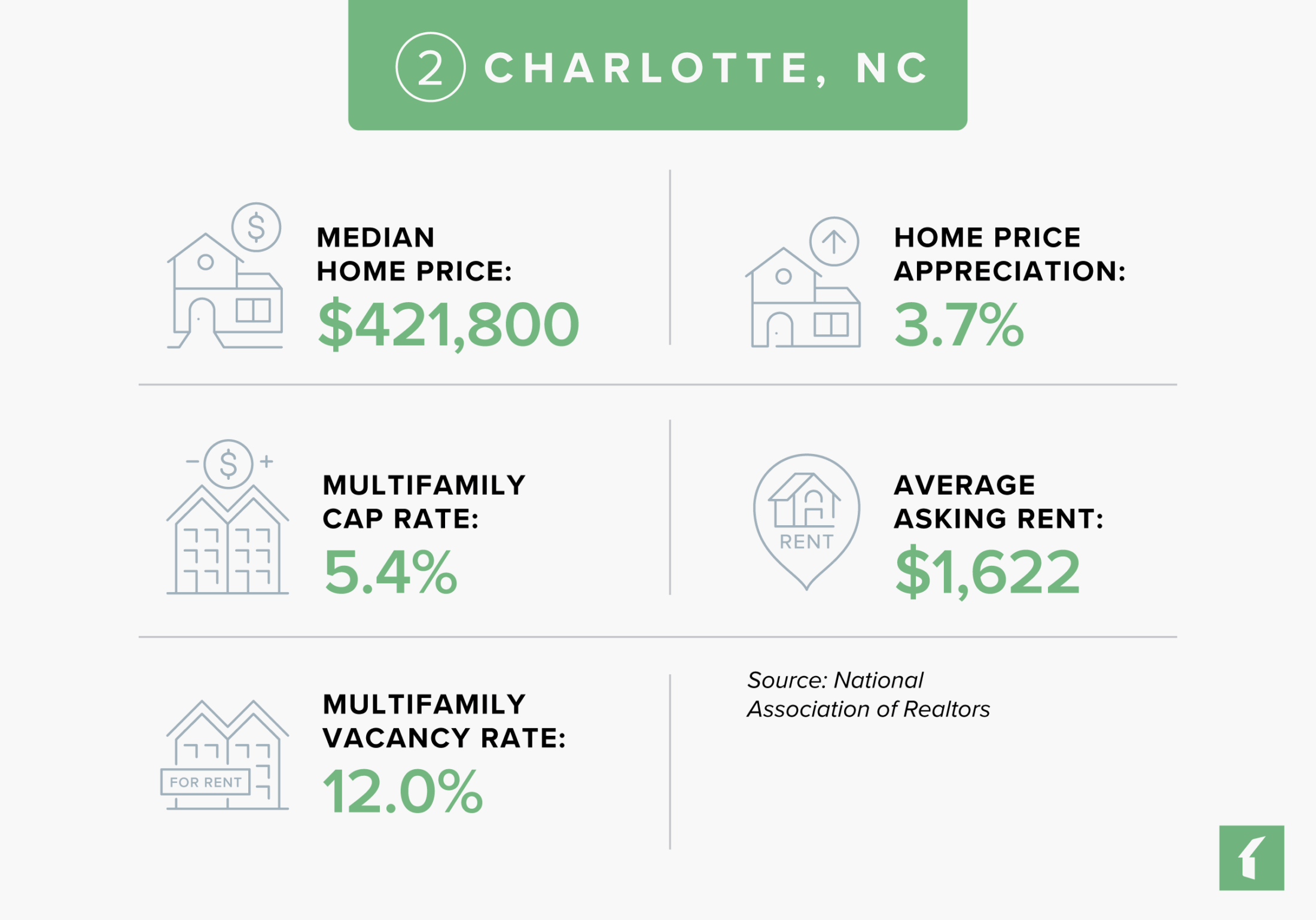
Charlotte, NC Rental Market Statistics
- Rental Inventory (Q3-’24): 228,025
- Units Added Since Q3-’23: +4,009
- Asking Rent Growth Since Q3-’23: -0.9%
- Asking Rent (Q3-’24): $1,622
- Effective Rent (Q3-’24): $1,594
- Multifamily Vacancy Rate (Q3-’24): 12.0%
- Multifamily Cap Rate (Q3-’24): 5.4%
Source: National Association of Realtors
Charlotte, NC Housing Market Statistics
- Median Home Price (Q3-’24): $421,800
- Home Price Appreciation Since Q3-’23: 3.7%
Source: National Association of Realtors
Charlotte, NC Economic Statistics
- Population Growth (2023): 1.8%
- GDP Growth (2023): 9.8%
- Job Growth (Q3-’24): 2.2%
Source: National Association of Realtors
Lists That Mention Charlotte, NC
- Emerging Housing Markets Index – Winter 2024 (WSJ/Realtor.com): #92
- Emerging Housing Markets Index – Spring 2024 (WSJ/Realtor.com): #43
- Markets to Watch – Overall Real Estate Prospects (PwC/ULI): #18
- Best Real Estate Markets – Large Cities (WalletHub): #2
Market #3: Winston-Salem, NC
The Winston-Salem metro area’s 695,630 residents make it the fifth-most populous city in North Carolina. Together with Greensboro and High Point, Winston-Salem is part of the Piedmont Triad.
Early on in its history, Winston-Salem was known for tobacco and textile manufacturing, eventually becoming the home of major corporations like R.J. Reynolds and Hanes. During the 1980s and ‘90s, globalization and automation led to a decline in traditional manufacturing, causing many of the area’s textile mills to close. However, as with the other North Carolina cities we’ve discussed in this post, this shift led the city to diversify its economy.
Today, Winston-Salem is known as a center for healthcare, education, and technology. Major employers in the area include Atrius Health Wake Forest Baptist, Novant Health, Winston-Salem/Forsyth County Schools, the local government, and Wells Fargo, in addition to Reynolds and Hanes, which are still headquartered in Winston-Salem. In addition, one of the city’s defining features is the presence of a number of higher education institutions, with Wake Forest University, Winston-Salem State University, and the UNC School of the Arts located here.
Residents and visitors to Winston-Salem can enjoy cultural attractions like Old Salem Museums & Gardens, Reynolda House Museum of American Art, Southeastern Center for Contemporary Art, and Reynolda Gardens. They can also catch performances by the Piedmont Opera and Winston-Salem Symphony, attend the National Black Theatre Festival or RiverRun International Film Festival, or view art in an urban park setting at Activity on the Green.
Winston-Salem is growing fast, and its student population provides a steady source of rental demand. The market hasn’t received as much new supply as more prominent North Carolina rental markets have, so rent growth has remained relatively strong. This, in addition to the market’s relative affordability, may make Winston-Salem an appealing option for investors and property managers looking to expand within the Carolinas.

Winston-Salem, NC Rental Market Statistics
- Rental Inventory (Q3-’24): 34,908
- Units Added Since Q3-’23: +89
- Asking Rent Growth Since Q3-’23: 2.9%
- Asking Rent (Q3-’24): $1,209
- Effective Rent (Q3-’24): $1,195
- Multifamily Vacancy Rate (Q3-’24): 9.1%
- Multifamily Cap Rate (Q3-’24): 6.4%
Source: National Association of Realtors
Winston-Salem, NC Housing Market Statistics
- Median Home Price (Q3-’24): $310,500
- Home Price Appreciation Since Q3-’23: 3.7%
Source: National Association of Realtors
Winston-Salem, NC Economic Statistics
- Population Growth (2023): 1.0%
- GDP Growth (2023): 7.5%
- Job Growth (Q3-’24): 1.3%
Source: National Association of Realtors
Lists That Mention Winston-Salem, NC
- Emerging Housing Markets Index – Winter 2024 (WSJ/Realtor.com): #109
- Emerging Housing Markets Index – Spring 2024 (WSJ/Realtor.com): #52
- Best Real Estate Markets – Mid-Sized Cities (WalletHub): #50
Market #4: Raleigh, NC
Raleigh is the second-most populous city in North Carolina, with 1,509,231 residents living in the Raleigh-Cary metro area. It’s also the largest city within North Carolina’s Research Triangle, an area that also includes Durham and Chapel Hill, and is known as one of the most dynamic innovation corridors in the U.S.
Over the years, Raleigh has grown from a modest government outpost to a thriving hub of technology and education. The city’s role as the state capital has long anchored its economy, with the North Carolina state government standing out as the area’s largest employer by far. In addition, North Carolina State University, founded in 1887, has been a major employer and driver of innovation in the region. Other top employers in Raleigh include the Wake County Public School System, WakeMed Health and Hospitals, and UNC Rex Healthcare. Since the 2000s, Raleigh has also received an influx of startups across the tech, financial, and life sciences sectors.
There are a number of cultural attractions clustered in Raleigh, including the North Carolina Museum of Art, North Carolina Museum of Natural Sciences, and North Carolina Museum of History. Residents and visitors can see the Carolina Ballet, Opera, and Symphony at the Duke Energy Center for the Performing Arts. In addition, Raleigh—known as the City of Oaks—has a number of green spaces, including Dorothea Dix Park, William B. Umstead State Park, and the Neuse River Greenway Trail. Visitors also flock to Pullen Park, one of the world’s oldest amusement parks, as well as annual festivals like the North Carolina State Fair, Artsplosure, and Hopscotch Music Festival.
Strong population growth in Raleigh has resulted in record rental demand in recent years. In response, developers in the city have built tens of thousands of new rental units, with inventory growing by a total of 25% over the last five years, according to RealPage Analytics. As a result, vacancy rates are relatively high, and rent growth has drifted into the negative over the past year. However, the market’s demand outlook remains strong, which is likely to bring Raleigh back onto investors’ radar in future years.
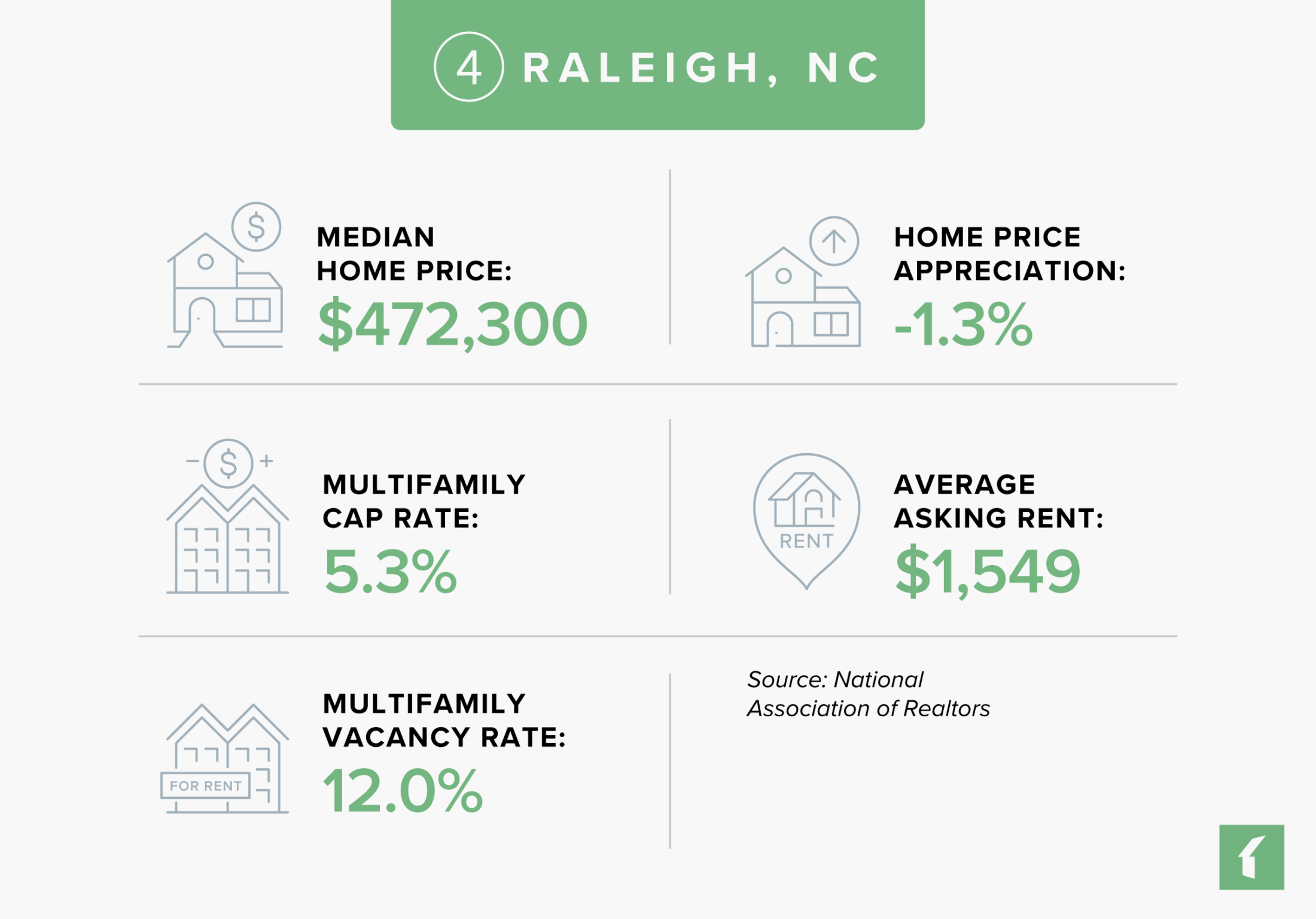
Raleigh, NC Rental Market Statistics
- Rental Inventory (Q3-’24): 132,341
- Units Added Since Q3-’23: +2,133
- Asking Rent Growth Since Q3-’23: -2.7%
- Asking Rent (Q3-’24): $1,549
- Effective Rent (Q3-’24): $1,522
- Multifamily Vacancy Rate (Q3-’24): 12.0%
- Multifamily Cap Rate (Q3-’24): 5.3%
Source: National Association of Realtors
Raleigh, NC Housing Market Statistics
- Median Home Price (Q3-’24): $472,300
- Home Price Appreciation Since Q3-’23: -1.3%
Source: National Association of Realtors
Raleigh, NC Economic Statistics
- Population Growth (2023): 1.7%
- GDP Growth (2023): 9.5%
- Job Growth (Q3-’24): 2.0%
Source: National Association of Realtors
Lists That Mention Raleigh, NC
- Emerging Housing Markets Index – Winter 2024 (WSJ/Realtor.com): #203
- Emerging Housing Markets Index – Spring 2024 (WSJ/Realtor.com): #99
- Markets to Watch – Overall Real Estate Prospects (PwC/ULI): #12
- Best Real Estate Markets – Large Cities (WalletHub): #4
- Best Places to Live (U.S. News): #155
Market #5: Wilmington, NC
Wilmington is located in southern North Carolina between the Atlantic Ocean and the Cape Fear River. 467,337 residents call the Wilmington, NC metro area home, making it the eighth-most populous city in the state.
Wilmington has been a vital port since the city’s incorporation in 1739. The construction of the Wilmington & Weldon Railroad in 1840 further boosted trade there, with the city’s economy diversifying into manufacturing, shipping, and rail transport by the 1900s. Shipbuilding and military installations during World War II helped to revitalize an economy that had flagged during the Great Depression. This wasn’t the only challenge that Wilmington would face: Though the city found success in textile and chemical manufacturing during the post-war industrial boom, the movement toward deindustrialization again threatened its economy in the latter half of the twentieth century.
However, in the 1990s and 2000s, Wilmington experienced a renaissance, with tourism surging due to its proximity to the beach and efforts to revitalize its downtown. A booming film industry also earned the city the nickname “Hollywood East.” Overall, this period marked a shift toward a more service-based economy, with growth across the hospitality, retail, and healthcare sectors. Today, top employers in Wilmington include Novant Health, New Hanover County Schools, the local government, GE Hitachi Nuclear Energy, and Thermo Fisher Scientific. In addition, the University of North Carolina Wilmington and Cape Fear Community College play an important role in the local economy.
Wilmington visitors can experience the city’s rich history by visiting the WWII-era Battleship North Carolina, the Bellamy Mansion Museum, Latimer House, Burgwin-Wright House, and the Wilmington Railroad Museum. Additional cultural attractions located here include Cape Fear Museum of History and Science, the Cameron Art Museum, and the Children’s Museum of Wilmington. There are also opportunities for outdoor recreation at Airlie Gardens, the New Hanover County Arboretum, and the Wilmington Riverwalk, as well as the popular waterpark Jungle Rapids.
Wilmington has experienced considerable expansion for a market of its size over the last few years, with its inventory growing by an unmatched 36%, according to RealPage Analytics. As a result, vacancy rates have increased, and rent growth has fallen slightly. However, as with the other North Carolina markets we’ve discussed, rental demand in Wilmington remains strong, so occupancy and rental prices are expected to strengthen as absorption catches up with supply. Investors interested in a coastal market that attracts students, retirees, and remote workers may find Wilmington appealing.
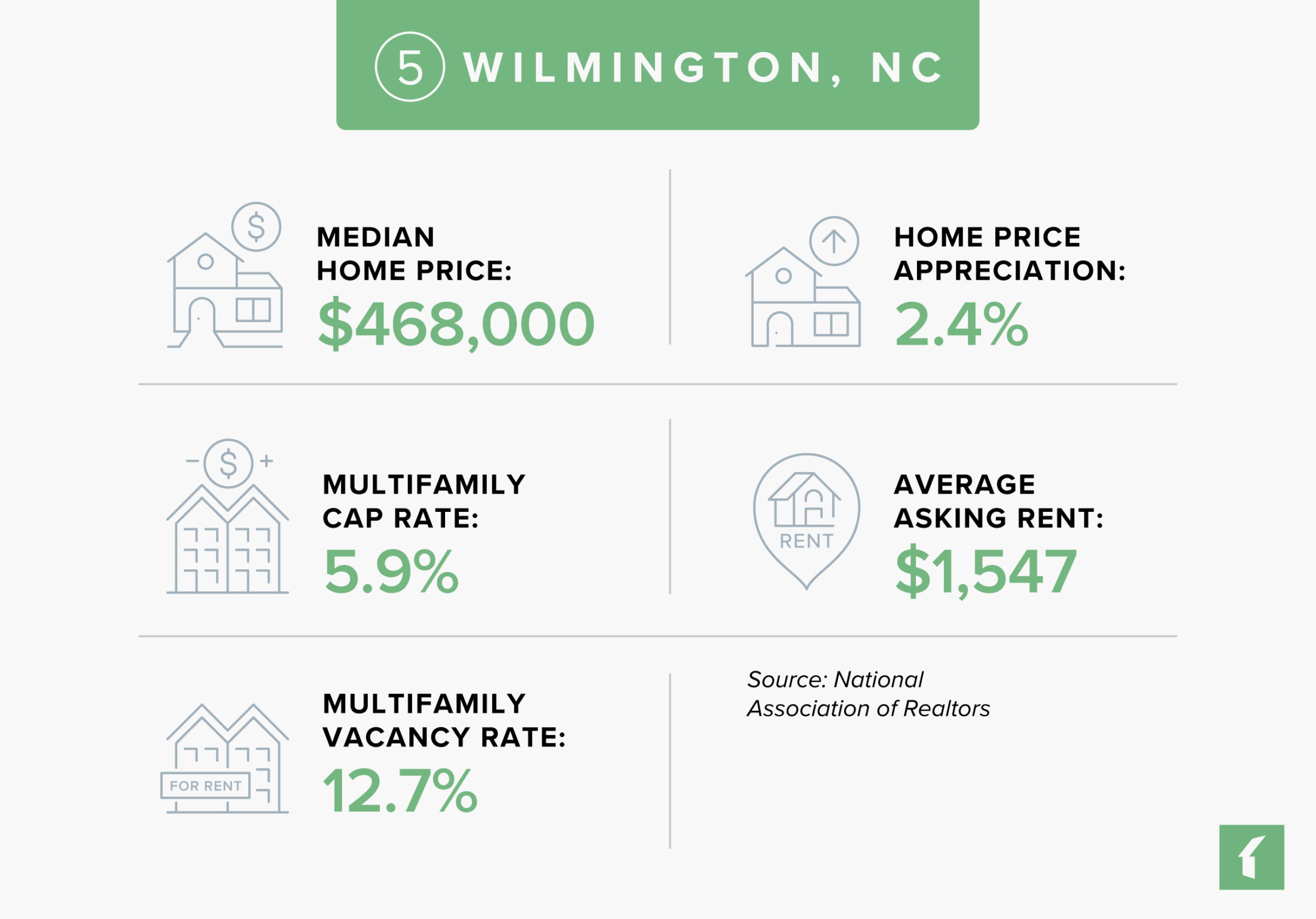
Wilmington, NC Rental Market Statistics
- Rental Inventory (Q3-’24): 27,534
- Units Added Since Q3-’23: +607
- Asking Rent Growth Since Q3-’23: -1.0%
- Asking Rent (Q3-’24): $1,547
- Effective Rent (Q3-’24): $1,522
- Multifamily Vacancy Rate (Q3-’24): 12.7%
- Multifamily Cap Rate (Q3-’24): 5.9%
Source: National Association of Realtors
Wilmington, NC Housing Market Statistics
- Median Home Price (Q3-’24): $468,000
- Home Price Appreciation Since Q3-’23: 2.4%
Source: National Association of Realtors
Wilmington, NC Economic Statistics
- Population Growth (2023): Unavailable
- GDP Growth (2023): 8.6%
- Job Growth (Q3-’24): 1.7%
Source: National Association of Realtors
Lists That Mention Wilmington, NC
- Emerging Housing Markets Index – Winter 2024 (WSJ/Realtor.com): #93
- Emerging Housing Markets Index – Spring 2024 (WSJ/Realtor.com): #98
- Best Real Estate Markets – Large Cities (WalletHub): #12
How Do We Identify the Best Rental Markets in North Carolina?
We use the following sources to help us ascertain the best rental markets in the U.S. across five different categories.
Industry Indicators
Measures of opportunity for rental property investors and property managers:
- Markets with the best overall real estate investment prospects, as measured by PwC and the Urban Land Institute
- Housing markets with emerging investment opportunities, as measured by the Wall Street Journal and Realtor.com
- Markets with a greater number of renters relative to homeowners, as measured by the National Association of Realtors
- Markets with a high rate of renter household formation, as measured by the National Association of Realtors
Housing Indicators
Measures of property prices and rent growth:
- Markets with the highest growth in asking rents, as measured by the National Association of Realtors
- Markets with the lowest rental property vacancy rate, as measured by the National Association of Realtors
- Markets with the highest rental property cap rates, as measured by the National Association of Realtors
- Markets with the most home price appreciation, as measured by the National Association of Realtors
- Markets with affordable monthly mortgage payments relative to income, as measured by the National Association of Realtors
Economic and Job Market Indicators
Measures of employment growth:
- Markets with the lowest unemployment rates, as measured by the National Association of Realtors
- Markets with the most employment growth, as measured by the National Association of Realtors
- Markets with the most GDP growth, as measured by the National Association of Realtors
- States with the most economic activity, as measured by the National Association of Realtors
Demographic Indicators
Measures of population growth:
- Markets with the greatest population growth, as measured by the National Association of Realtors
- The fastest-growing real estate markets, as measured by U.S. News
- The best places to live, based on analyses of quality of life and desirability, as measured by U.S. News
Climate Indicators
Measures of climate vulnerability:
- Markets with the lowest risk of natural disasters and extreme conditions, as measured by the Federal Emergency Management Agency
60 Up-and-Coming Real Estate Markets in 2025
In Buildium’s annual Up-and-Coming Real Estate Markets list, we analyzed 175 metro areas across the U.S. to determine which cities show promise for rental investors and property managers in the year ahead. Wondering where else can rental investors and property managers find more growth opportunities in 2025? View the full list of emerging markets we’ve identified across the country.
Read more on Industry Research